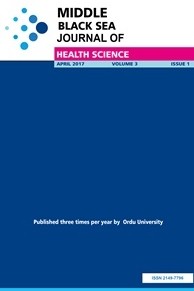Ferit KAYA, Yasemin AÇIK, Osman AKTAŞ, Cahit POLAT, Abdulkadir KANTARCIOĞLU, Yavuz ORAK, Gonca AKTAŞ
Safety Feeling and Satisfaction Rates of Syrians Under Temporary Protection in Turkey's Eastern Province
Objective: This study aims to determine safety feeling and satisfaction rates of Syrians under temporary protection in an eastern province of Turkey.Methods: This study is a cross-sectional study. The study was conducted among Syrians under temporary protection over the age of 18 living in a province in the eastern Anatolian region of Turkey. Results: The average time of living of the Syrians in Turkey was 24.36 ± 15.46. 53.9% of the participants were women, and 46.1% were men. The average age of women was 37.18±11.59, while the average age of men was 37.59 ± 11.10. The average number of people staying at home was 6.95 ± 3.05. 69.6% of the participants in the study had a nuclear family structure. The ratio of disabled family members was 13.1%. 70.8% of those included in the study considers returning to Syria again. There was a positive correlation between the increase in family income and age and the average feeling of being safe. The average score of feeling safe was significantly higher in those who did not have the idea of returning to Syria.Conclusion: It has been observed that people do not have problems in accessing health services and the education of their children, but they have problems mostly due to language and economic difficulties.
___
- 1. Ilgin C, Hacihasanoglu O. A model for migration – attachment relations: example Berlin/ Kreuzberg. Journal of Itu. 2006; 5(2): 59–70.
- 2. Goker G. Immigration Identity Belonging. Literature Academia Publications, Konya: 2015. pp. 25.
- 3. Ozgur N, Ozer Y. Europeanization of the asylum system in Turkey. Istanbul: Derin publication; 2010. pp. 132-148.
- 4. Kaya A. Syrian refugees and cultural intimacy in Istanbul: I feel safe here. Electronic Journal. 2016; doi:10.2139/ssrn.2870516.
- 5. UNHCR (2019). Situation Syria regional refugee response. Online: https://data2.unhcr.org/en/situations/syria
- 6. Turkler G. Migration, identity, belonging. Swedish Turks in terms of intercultural communication. Konya: Ipek press; 2015. pp. 3-10.
- 7. Detels R, Gulliford M, Tan C, Karim Q. Oxford textbook of global public health. 6th ed. Oxford: Oxford Universty Press; 2015. pp. 2986
- 8. Gilbert P, Mcevan K, Mitra R, Richter A. An exploration of different types of positive affect in students and patients with a bipolar disorder. Clinical Neuropsychiatry. 2009;6(4):135-143.
- 9. Kloosterman R, Moons E. Social economische trends veiligheidsbeleving van herkomstgroepen. CBS. 2017;05:2–17.
- 10. Alsharabati C, Nammour J. Survey on Perceptions of Syrian Refugees in Lebanon. 2015; Online: https://data2.unhcr.org/en/documents/details/45083
- 11. Akin A. Current measurement tools used in psychology. 2th ed. Ankara: 2015; Nobel bookstore. pp. 439-40.
- 12. ORSAM (2015). Effects of the Syrian refugees in Turkey. 2021; Online: http://cib-uclg.org/sites/default/files/a._reporteffects_of_the_syrian_refugees_on_Turkey.
- 13. Celik K. Cross-cultural sensitivity and living together. Ankara: 2018; HUKSAM.
- 14. AFAD. Field research on the demographic view, living conditions and future expectations of Syrians in Turkey. 2017; Online: https://www.afad.gov.tr/suriye-raporlari.
- 15. Erdogan M. Syrians Barometer, “A Framework for achieving social cohesion with Syrians In Turkey. 2017; Online: http://www.goc.gov.tr/icerik6/uluslararasi-koruma_0_378_4712_icerik (2017).
- 16. Balkan B, Tumen S. Immigration and prices: quasi-experimental evidence from Syrian refugees in Turkey. Journal of Population Economics. 2016;29:657–86.
- 17. ILO. Assessment of the impact of Syrian refugees in Lebanon and their employment profile. [İnternet]. 2021. Available from: https://www.ilo.org/wcmsp5/groups/public/---arabstates/---ro-beirut/documents/publication/wcms_240134.pdf.
- 18. Korkmaz E. Working papers how do Syrian refugee workers challenge supply chain management in the Turkish garment industry? The IMI Working papers series. 2017;133:1-18.
- 19. Dincer OB, Federici V, Ferris E, Karaca S, Kirisci K, Carmikli EO. Turkey and Syrıan refugees: the limits of hospitality. Ankara: Brooking. 2019.
- 20. Culbertson S, Constant L. Education of Syrian refugee children: Managing the crisis in Turkey, Lebanon. Santa Monica: RAND; 2015.
- 21. UNHRC. Return ıntentıons survey overvıew [internet]. 2018. Available from: https://data2.unhcr.org › documents › download
- 22. UNHRC. Situation syria regional refugee response: Durable solutions [Internet]. Available from: https://data2.unhcr.org/en/situations/syria.
- 23. UNHRC Regional operational framework for refugee return to syrıa [Internet]. 2019. Available from: https://data2.unhcr.org/en/documents/details/63223.
- 24. Reliefweb far from home future prospects for Syrian refugees in Iraq [Internet] 2019. Available from: https://reliefweb.int/report/iraq/far-home-future-prospects-syrian-refugees-iraq.
- 25. Konak M, Kork A. Trust in social relationships. Malatya: 2017. pp. 117-18.
- 26. 26.Wood L, Shannon T, Bulsara M, Pikora T, McCormack G, Giles-Corti B. The anatomy of the safe and social suburb: an exploratory study of the built environment, social capital and residents' perceptions of safety. Health Place. 2008;14(1):15-31.
- 27. Yesilyaprak T, Ozsaker E. The Investigation of the patients’ opinions about the operating room environment DEUHFED. 2018;11(4):315-21.
- 28. Joınt Agency Research Report. Rohingya refugee response gender analysis: Recognizing and responding to gender inequalities [internet]. 2018. Available from: https://reliefweb.int/sites/reliefweb.int/files/resources/rr-rohingya-refugee-response-gender-analysis-010818-en.pdf.
- Yayın Aralığı: Yılda 4 Sayı
- Başlangıç: 2015
- Yayıncı: Ordu Üniversitesi
Sayıdaki Diğer Makaleler
Ferit KAYA, Yasemin AÇIK, Osman AKTAŞ, Cahit POLAT, Abdulkadir KANTARCIOĞLU, Yavuz ORAK, Gonca AKTAŞ
Selami KARADENİZ, Murat BÖLÜKBAŞI
Asena KELEŞ ŞAHİN, Aslıhan UZUN
Nurgül BÖLÜKBAŞ, Zeliha YÖNDEM
Ercan TÜRKMEN, Ahmet KARATAŞ, Yusuf Taha GULLU
Osman İNAN, Muhammed Fatih ACEHAN, Buket KARSAVURANOĞLU, Enes Seyda ŞAHİNER, Meryem ASLAN, İhsan ATEŞ
Gürkan ÇIKIM, Mehmet Yalçın GÜNAL, Abdullah TOK, Metin KILINÇ, Kemal HANSU, Solmaz SUSAM
